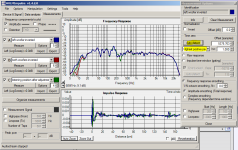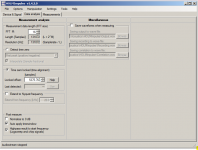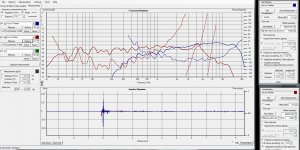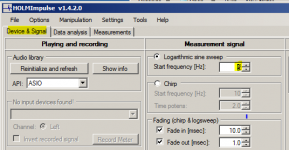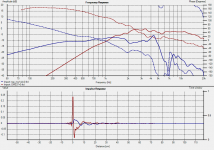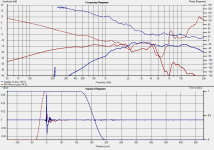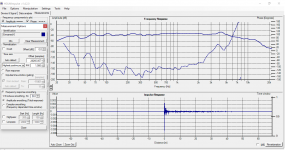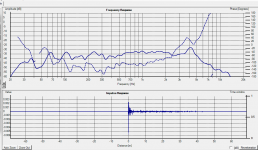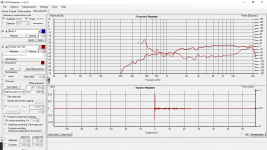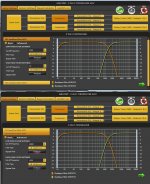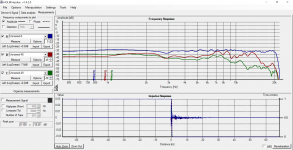Jon, Tony,
Thank you for helping me out with this:
Phase and Raw drivers (woofers only).
Interesting the phase line are so close at the xo point.
In the second screen shot, green is a 1.5mh baffle step coil (vs. the 1.2mh) but it can be spooled out easily for testing. I though the 90 degree angle was trouble, but now sounds like an acoustical filter.
Thank you for helping me out with this:
Phase and Raw drivers (woofers only).
Interesting the phase line are so close at the xo point.
In the second screen shot, green is a 1.5mh baffle step coil (vs. the 1.2mh) but it can be spooled out easily for testing. I though the 90 degree angle was trouble, but now sounds like an acoustical filter.
Attachments
Last edited:
OK, looks like the phase is different for each measurement. Holm impulse lets you lock time zero so that your measurements include the relative phase differences. To do this you need to do the following:
Set up with the mic on axis with the tweeter.
Take a measurement of the tweeter.
click on the options button for the measurement and set up as below
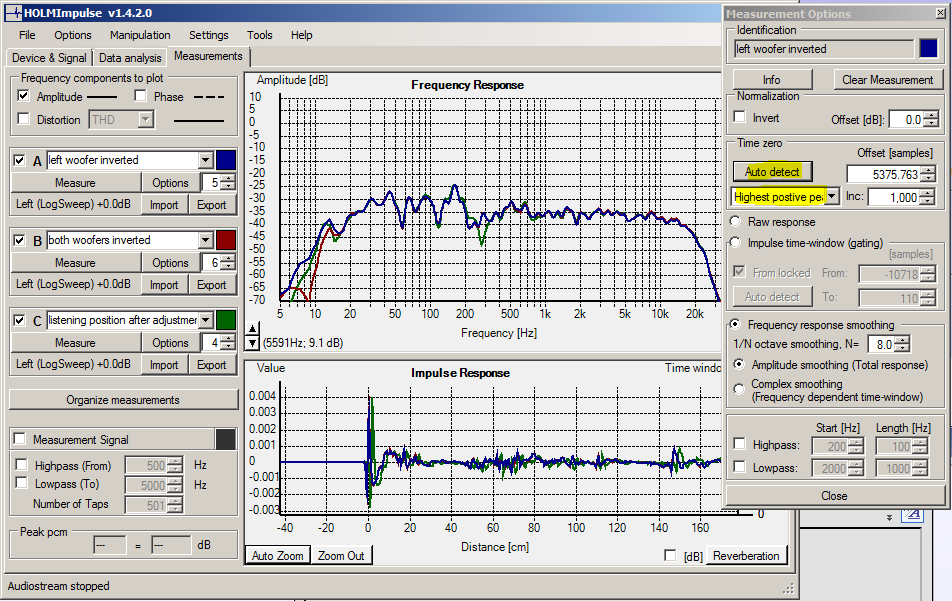
Specifically the highligted bits. change the detect time zero to highest positive peak (if your impulse has the biggest pulse negative you probably need to tick the invert recorded signal option in the Device and Signal tab). Click on the Auto Detect button twice (it doesn't seem to always get it right the first time).
Copy the value in the offset samples box.
Go to the Data Anaysis tab and set up as below:
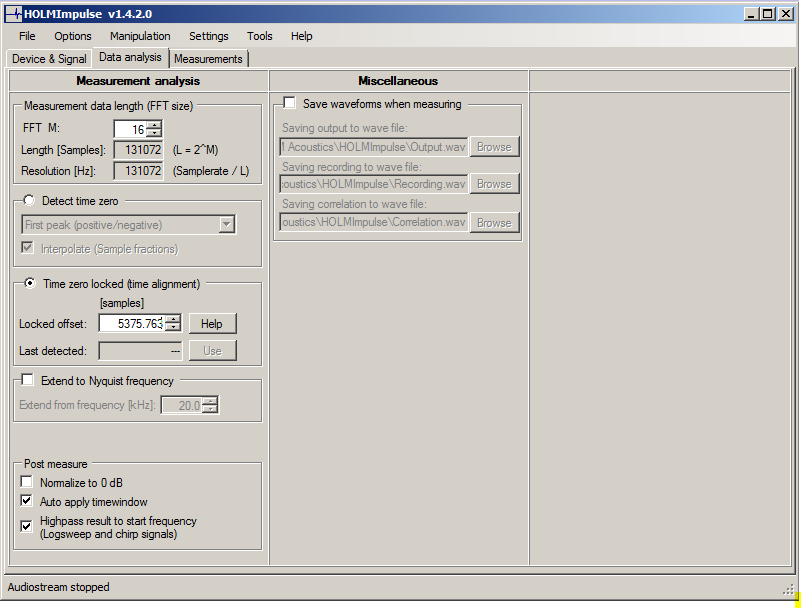
specifically choosing the time zero locked button, and pasting in the offset we copied above.
Now take a measurement of the woofers (without changing any thing else in the setup).
Your woofer and tweeter measurements will now show the relative phase difference between the drivers. and these measurements can be used for simulating the crossover.
For sanity check purposes you can take a third measurement which is with Both the woofers and the tweeter all running (again changing anything else).
You can combine the individual woofer and tweeter measurements in a crossover tool and what you get should match the measurement of all three drivers running together.
If this is the case your measurements should be good for crossover design.
Note I'm on a new machine with a new holmimpulse install so some of the other settings on the data analysis tab may be different to what I would normally use. I'm going to have to check, but the time zero is the most important for measurements that can be used for crossover modelling (alternatively you can work out the driver z offset using the three drivers running together measurement, there is a document on how to do so by Jeff Bagby. But the time zero measurements are probably the easiest to deal with.
edit: as a final sanity check you can take another measurement of the tweeter and it should be exactly the same as the first one. Note I was using 1/8th octave smoothing rather than gating for this measurement as I was looking at the room effects.
Tony.
Set up with the mic on axis with the tweeter.
Take a measurement of the tweeter.
click on the options button for the measurement and set up as below
Specifically the highligted bits. change the detect time zero to highest positive peak (if your impulse has the biggest pulse negative you probably need to tick the invert recorded signal option in the Device and Signal tab). Click on the Auto Detect button twice (it doesn't seem to always get it right the first time).
Copy the value in the offset samples box.
Go to the Data Anaysis tab and set up as below:
specifically choosing the time zero locked button, and pasting in the offset we copied above.
Now take a measurement of the woofers (without changing any thing else in the setup).
Your woofer and tweeter measurements will now show the relative phase difference between the drivers. and these measurements can be used for simulating the crossover.
For sanity check purposes you can take a third measurement which is with Both the woofers and the tweeter all running (again changing anything else).
You can combine the individual woofer and tweeter measurements in a crossover tool and what you get should match the measurement of all three drivers running together.
If this is the case your measurements should be good for crossover design.
Note I'm on a new machine with a new holmimpulse install so some of the other settings on the data analysis tab may be different to what I would normally use. I'm going to have to check, but the time zero is the most important for measurements that can be used for crossover modelling (alternatively you can work out the driver z offset using the three drivers running together measurement, there is a document on how to do so by Jeff Bagby. But the time zero measurements are probably the easiest to deal with.
edit: as a final sanity check you can take another measurement of the tweeter and it should be exactly the same as the first one. Note I was using 1/8th octave smoothing rather than gating for this measurement as I was looking at the room effects.
Tony.
Attachments
Last edited:
Tony,
Thank you for taking the time to post all of this.
I did work on this yesterday, and had some success, but not seeing much in the lower impulse response...will have more time later today/
The phase shift with the mock up xo was getting old and thought it would be a good idea to set them up active. Which sounded very nice and reassuring that the speakers do work well together. Reversed the tweeter, and noticed a dip in the response.
*12db xo slope
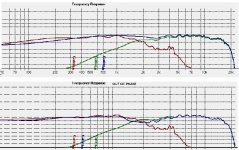
Thank you for taking the time to post all of this.
I did work on this yesterday, and had some success, but not seeing much in the lower impulse response...will have more time later today/
The phase shift with the mock up xo was getting old and thought it would be a good idea to set them up active. Which sounded very nice and reassuring that the speakers do work well together. Reversed the tweeter, and noticed a dip in the response.
*12db xo slope

Last edited:
Tony,
Better, much better, although not seeing a lot in the lower window.
No xo's - only a 15uf cap in series with the tweeter + for protection.
Better, much better, although not seeing a lot in the lower window.
No xo's - only a 15uf cap in series with the tweeter + for protection.
Attachments
Last edited:
Hmmm I think the time zero is off. The cap in series with the tweeter whilst good for protection will affect the phase. You can go into the devices tab and choose sine for testing and set the start frequency to say 200 Hz.
I have robust tweeters so I actually sweep them from 20Hz at times.
I've actually started using REW so that I can get accurate phase (using 2nd channel) It is interesting to import measurements that I took in REW in holm and detect time zero and then set the offsets for both drivers. The phase looks better with the REW imports.
One thing that may be happening is your sound card may not have constant latency. If the latency changes from measurement to measurement you won't get usable phase data with Holm. I think rew with the dual channel setup will cope with latency variances.
First graph is measurement done in holm (both woofers running) second was done in REW (only one woofer)
Tony.
I have robust tweeters so I actually sweep them from 20Hz at times.
I've actually started using REW so that I can get accurate phase (using 2nd channel) It is interesting to import measurements that I took in REW in holm and detect time zero and then set the offsets for both drivers. The phase looks better with the REW imports.
One thing that may be happening is your sound card may not have constant latency. If the latency changes from measurement to measurement you won't get usable phase data with Holm. I think rew with the dual channel setup will cope with latency variances.
First graph is measurement done in holm (both woofers running) second was done in REW (only one woofer)
Tony.
Attachments
Hi Doug, You've got 200 db on the scale there, that is making it look a lot smoother than it really is 😉 Try setting it to 60db to get a better idea of what's happening in your room. regardless it is looking pretty good 🙂
Tony.
Tony.
ok getting somewhere;
mic is 3' from speaker
mic is 3' from speaker
Attachments
Last edited:
Well they look symmetrical,,,but idk
The wife and I are loving the new sounds in the family room, especially piano playback.
The Dayton tweeter I was using did blend with the Anarchy, but this is a whole new ball game with the Wavecor. Can see why they bumped up the price a bit, although they were on sale a couple of weeks ago for $75.
Very interested in a passive xo; although for now, doubled-up on amps with an analog xo, and also ordered a miniDSP 2x4.
The wife and I are loving the new sounds in the family room, especially piano playback.
The Dayton tweeter I was using did blend with the Anarchy, but this is a whole new ball game with the Wavecor. Can see why they bumped up the price a bit, although they were on sale a couple of weeks ago for $75.
Very interested in a passive xo; although for now, doubled-up on amps with an analog xo, and also ordered a miniDSP 2x4.
Trying the minidsp, but still having the same problem with tweeter inversion, just a slight dip at the xo point. Tried ALL the xo settings: BW, Linkwitz.
There was hope at one point, a opposing tweeter inversion with the BW30db setting(s), but didn't sound right. The 18db sounded the best with 1100/1200 set points. According to the graph, this is 3 - 4 db down @ 1200hz (approx)
I wonder if anyone has any advice for a MTM configuration?
There was hope at one point, a opposing tweeter inversion with the BW30db setting(s), but didn't sound right. The 18db sounded the best with 1100/1200 set points. According to the graph, this is 3 - 4 db down @ 1200hz (approx)
I wonder if anyone has any advice for a MTM configuration?
Ernperkins,
Trial and error at this point.
Install the MINIdsp in the system yesterday, it sounded ok, but the xo settings need more work.
Went back to the rolls (24db fixed) just to check what sounds the best, 1,500hz does seem to work the best. [vs. 1,000hz & 2,000hz]
(Attachment=Rolls)
Also increased the tweeter protection caps to 25uf.
Will remove the MINI and try to copy the results from the Rolls.
Trial and error at this point.
Install the MINIdsp in the system yesterday, it sounded ok, but the xo settings need more work.
Went back to the rolls (24db fixed) just to check what sounds the best, 1,500hz does seem to work the best. [vs. 1,000hz & 2,000hz]
(Attachment=Rolls)
Also increased the tweeter protection caps to 25uf.
Will remove the MINI and try to copy the results from the Rolls.
Attachments
Last edited:
Really enjoying the minidsp speaker setup. Was able dial in a xo point and make other adjustments in a few hours.
Phase: By trying several different settings (quickly) was able to minimize the delay down to .18ms.
Low end: Lost some of the bass without a baffle step coil, which is ok, the roll-off is smooth and simply hooked up the subwoofer which was easy to blend in.
Tweeters: REALLY like the tweeters, highly recommend those to folks.
Used a different plugin, but this was similar and informative:
YouTube
Phase: By trying several different settings (quickly) was able to minimize the delay down to .18ms.
Low end: Lost some of the bass without a baffle step coil, which is ok, the roll-off is smooth and simply hooked up the subwoofer which was easy to blend in.
Tweeters: REALLY like the tweeters, highly recommend those to folks.
Used a different plugin, but this was similar and informative:
YouTube
Attachments
Its been a while since I checked the Anarchy/Wavecor T11 mtm combination.
In this long break away from speakers, picked up a second hand 64-bit laptop and reloaded HolmImpule, including the UMIK-1 mic calibration.
The new set-up does work better with the 64-bit computer (which has a lot more memory/ram).
Next reloaded the minidsp parameters, using BW18db this time.
At first I thought the top blue line was too good to be true and hooked up other manufactured bookshelf speakers, obviously, they are poor quality or blown tweeter, but conformation the set-up rig is working.
Not shown is a Klipsch KG2.2V [MTM] which had a similar response to the DIY speaker but not quite as good.
In this long break away from speakers, picked up a second hand 64-bit laptop and reloaded HolmImpule, including the UMIK-1 mic calibration.
The new set-up does work better with the 64-bit computer (which has a lot more memory/ram).
Next reloaded the minidsp parameters, using BW18db this time.
At first I thought the top blue line was too good to be true and hooked up other manufactured bookshelf speakers, obviously, they are poor quality or blown tweeter, but conformation the set-up rig is working.
Not shown is a Klipsch KG2.2V [MTM] which had a similar response to the DIY speaker but not quite as good.
Attachments
Last edited:
- Home
- Loudspeakers
- Multi-Way
- Anarchy 7 - Wavecor MTM Crossover


